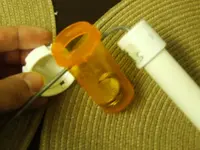Art---
At LSMorgan's request, let's keep this on-topic, huh?
First he will need a minimum parts list. Why don't you supply that, so he can get on with it?
Next, he will need to know the exact, formal, Theory of Operation, so he can make sure it's all connected right, and tuned-up properly. Your attempt, above in your #2, to substitute testimonials, for a standard electronics explanation, won't help him
any in this regard. (It also violates #4 in my list. Uh-oh, you goofed already. Shame on you!)
Next, he needs to know how to get the pointer to move. In your #2, above, you say he needs to apply the necessary voltage, but you don't tell us how much voltage that is. I guess a nice 440 to the ball bearing, with the rod grounded, would move it---probably blow it into the next county, though. So tell us what the proper voltage is, so we can all build one of these. After all, you only want to
help people, right?
Then, he will need to know what kind of reliability to expect, to make sure he has done a good job of building his. You say, in your #3 above, you have done 20m double blind tests. Usually a "m" stands for thousands (it couldn't be thousand
ths, that wouldn't make sense), so he can expect it to pass twenty thousand double blind tests in a row without a miss? OK, that's a good goal to shoot for, then. At one per day, that would only have taken you 5 1/2 years to do all those tests, that must have given you a lot of free time, then. Sweet.
By the way, your answer to my #4, refers to LRLs. But #4 is not about LRLs. Rather it is about the science of logic, and the Straw Man fallacy. So you failed again on that one, by actually using a Straw Man, to try to disprove the Straw Man statement itself. That's got to be an
all time low in logic! Congratulations!
Anything else you can do to help build one, would be appreciated. Oops, wait a minute, you haven't contributed
anything to help, have you?











